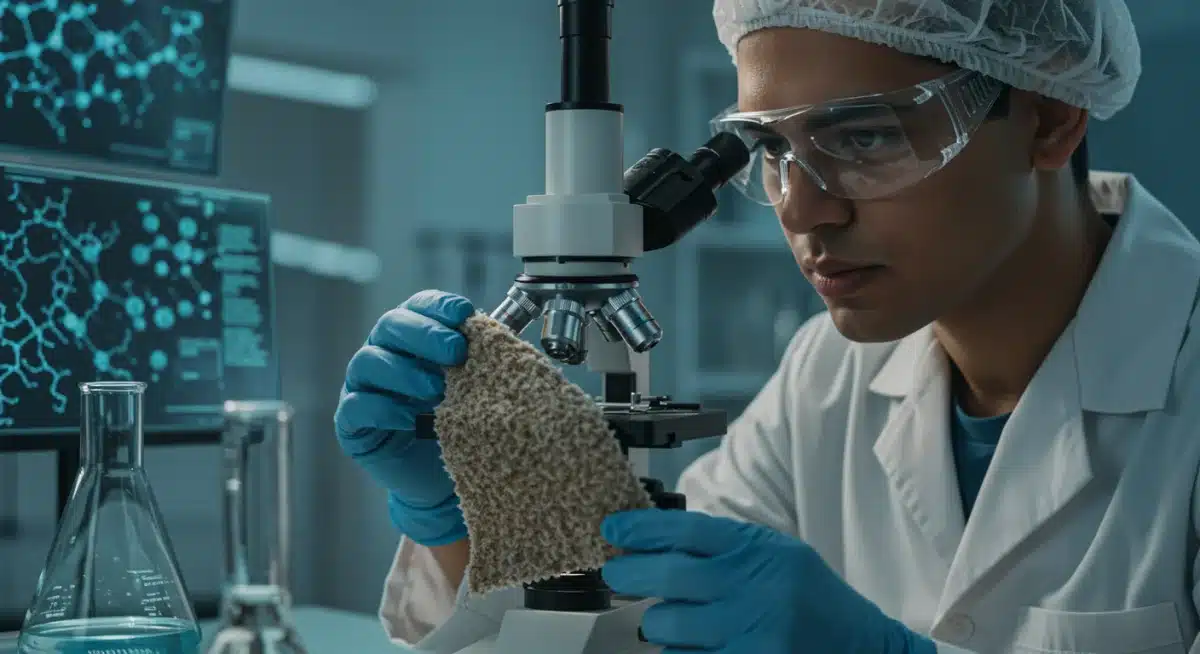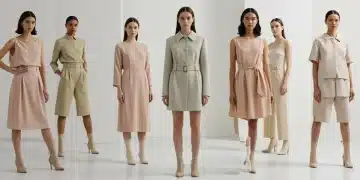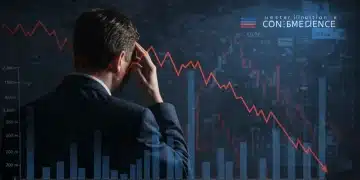Sustainable Fabric Innovations: 3 New Materials Shaping 2026 Fashion for American Consumers (Recent Updates)

Recent advancements in sustainable fabric innovations are poised to redefine 2026 fashion for American consumers, introducing three new materials that prioritize environmental responsibility and ethical production while meeting evolving consumer demands for eco-conscious apparel.
Sustainable fabric innovations are quickly becoming the driving force behind the future of fashion. As of early 2024, groundbreaking developments are rapidly accelerating the industry’s shift towards eco-conscious practices, directly impacting what American consumers will wear by 2026. This news report delves into three pivotal new materials set to revolutionize the fashion landscape.
The Rise of Mycelium-Based Leathers: A Fungi Future
The fashion industry is witnessing a significant shift towards bio-fabricated alternatives, with mycelium-based leathers emerging as a frontrunner. This innovative material, derived from the root structure of mushrooms, offers a compelling sustainable alternative to traditional animal leather and petroleum-based synthetics. Companies like MycoWorks and Bolt Threads are leading the charge, rapidly scaling production to meet anticipated demand by 2026.
Mycelium’s appeal lies in its rapid growth cycle and minimal environmental footprint. Unlike animal agriculture, which is resource-intensive, mycelium cultivation requires significantly less land, water, and emits fewer greenhouse gases. This makes it an incredibly attractive option for brands committed to reducing their ecological impact.
Cultivating Sustainable Style
The process of creating mycelium leather involves growing networks of fungal threads on agricultural waste. These threads then form a dense, interconnected mat that can be harvested, processed, and treated to mimic the look and feel of traditional leather. The resulting material boasts impressive durability and versatility, making it suitable for a wide range of fashion applications.
- Rapid Growth: Mycelium can grow in days or weeks, significantly faster than raising livestock.
- Reduced Resource Use: Requires minimal land and water compared to conventional leather production.
- Biodegradability: Offers a biodegradable end-of-life solution, unlike most synthetic leathers.
- Customizable Properties: Can be engineered for varying textures, strengths, and thicknesses.
As of late 2023, several luxury brands have already begun incorporating mycelium-based materials into their collections, signaling a strong market acceptance. The ongoing research focuses on enhancing the material’s performance characteristics, such as water resistance and abrasion durability, ensuring it meets the rigorous demands of the fashion industry for years to come.
Recycled Carbon Emissions Textiles: Turning Pollution into Apparel
A truly groundbreaking innovation in sustainable fabric innovations involves capturing carbon emissions and transforming them into wearable textiles. This technology, still in its nascent stages, presents a revolutionary approach to combating climate change by repurposing industrial pollutants into valuable resources. Startups like Mango Materials and LanzaTech are pioneering methods to convert greenhouse gases into polymers suitable for fiber production.
The concept is simple yet profound: instead of releasing carbon dioxide into the atmosphere, it is captured and fed to specialized microorganisms. These microbes then convert the CO2 into biopolymers, which can subsequently be spun into fibers. This process not only diverts harmful emissions but also creates new material streams that are inherently circular.
From Air to Wardrobe: The Science Behind It
The conversion of carbon emissions into textile fibers typically involves a fermentation process. Microbes act as tiny factories, metabolizing the carbon and producing a polymer known as PHA (polyhydroxyalkanoate). PHA is a biodegradable plastic that can be processed into fibers with properties similar to traditional polyesters, yet with a significantly reduced carbon footprint.
This technology is particularly appealing to industries with high emissions, offering a dual benefit of waste reduction and sustainable material creation. The challenge now lies in scaling these processes to meet the vast demands of the global fashion industry, a hurdle that innovators are actively addressing with significant investment and research.
The potential for these textiles to reshape the environmental impact of fashion is immense. By 2026, we could see a noticeable proliferation of garments made from recycled carbon emissions on store shelves, particularly as consumer awareness and demand for truly sustainable products continue to grow. This represents a tangible step towards a more regenerative fashion ecosystem.
Bio-Synthetics from Algae and Agricultural Waste: The Next Generation Fibers
Beyond mycelium and carbon capture, the realm of bio-synthetics is expanding to include materials derived from algae and various agricultural waste products. These innovations offer diverse pathways to create fabrics with reduced environmental impact, moving away from reliance on fossil fuels and virgin resources. Companies are exploring everything from seaweed-based fibers to textiles made from pineapple leaves and banana stems.
Algae, for instance, is a fast-growing organism that requires minimal resources and can even thrive in wastewater. Its biomass can be processed into polymers that are then spun into fibers. Similarly, agricultural waste, often discarded or burned, can be upcycled into textile-grade materials, providing economic opportunities for farmers and reducing waste streams.

Innovative Sourcing for Sustainable Textiles
The diversity of these new bio-synthetics means that designers and brands will have an unprecedented array of choices when it comes to material selection. This allows for greater creativity while adhering to strict sustainability criteria. The key benefit of these materials is their renewability and often their biodegradability, offering a truly circular design approach.
- Algae Fibers: Require less land and fresh water, and can sequester carbon.
- Pineapple Leaf Fiber (Piñatex): Utilizes waste from pineapple harvests, creating a leather alternative.
- Banana Fiber: Extracts cellulose from banana plant stems, offering a strong, durable textile.
- Orange Fiber: Transforms citrus processing by-products into a silky, sustainable fabric.
These materials are not just eco-friendly; many possess unique properties such as inherent breathability, antimicrobial qualities, and softness, making them highly desirable for various apparel categories. The development of these fibers underscores a holistic approach to sustainable fabric innovations, considering the entire lifecycle of the garment from source to disposal.
Consumer Demand Driving Innovation: The American Market Shift
The increasing availability and adoption of these new materials are not happening in a vacuum; they are directly influenced by a significant shift in American consumer preferences. A growing segment of the population, particularly younger generations, is prioritizing sustainability and ethical production when making purchasing decisions. This demand is creating a powerful incentive for brands to invest in and integrate sustainable fabric solutions.
Recent market research indicates a clear trend: consumers are willing to pay a premium for products that align with their values. This willingness to invest in eco-friendly fashion is accelerating the research and development cycles for new materials, pushing manufacturers to innovate at an unprecedented pace. Brands that fail to adapt risk losing market share to more forward-thinking competitors.
Educating for Eco-Conscious Choices
Part of this shift involves greater transparency from brands about their supply chains and material sourcing. Consumers are no longer satisfied with vague sustainability claims; they demand verifiable information about how and where their clothes are made. This pressure is forcing brands to re-evaluate their entire operational model, from raw material procurement to manufacturing processes.
The role of fashion media and influencers in educating the public about these new materials is also crucial. By highlighting the benefits and applications of mycelium leather, carbon-captured textiles, and bio-synthetics, they are helping to normalize their presence in the market and build trust among consumers. This collective effort is vital for the widespread adoption of these sustainable alternatives by 2026.
Challenges and Opportunities in Scaling Sustainable Production
While the promise of these new sustainable materials is immense, scaling their production to meet global fashion demands presents significant challenges. The infrastructure required for cultivating mycelium, capturing carbon, or processing agricultural waste into textile fibers is often complex and capital-intensive. Furthermore, ensuring consistent quality and performance across large-scale production runs is a continuous area of development.
However, these challenges also present substantial opportunities. Governments, venture capitalists, and established fashion conglomerates are increasingly investing in these innovative ventures, recognizing their long-term potential. Strategic partnerships between material science companies and fashion brands are crucial for bridging the gap between laboratory breakthroughs and commercial viability.
Overcoming Hurdles for a Greener Future
One of the primary hurdles is cost. Currently, many of these advanced materials are more expensive to produce than their conventional counterparts. As production scales and technologies mature, it is anticipated that costs will decrease, making them more accessible to a broader range of brands and consumers. This cost reduction is vital for widespread adoption.
Regenerative agriculture practices, which enhance soil health and biodiversity, are also playing a role in the broader ecosystem of sustainable fabric innovations. Sourcing raw materials from such practices ensures that even the feedstock for bio-synthetics is produced in an environmentally beneficial way. This holistic approach is essential for achieving true sustainability within the fashion industry.
The Future Landscape of Fashion: Beyond 2026
Looking beyond 2026, the trajectory for sustainable fabric innovations points towards an even more integrated and circular fashion economy. The materials currently in development are just the beginning. Expect to see further advancements in bio-engineering, smart textiles with embedded sustainable technologies, and increasingly sophisticated recycling processes that can handle mixed material garments.
The goal is to create a fashion system where waste is minimized, resources are continually regenerated, and the environmental footprint of clothing production is drastically reduced. This vision is not merely aspirational; it is becoming a tangible reality driven by scientific breakthroughs, consumer demand, and industry commitment. The coming years will undoubtedly bring more exciting developments.
The focus will intensify on traceability and transparency throughout the supply chain. Blockchain technology, for example, is already being explored to provide consumers with verifiable information about the origin and environmental impact of their garments. This level of detail will empower consumers to make truly informed choices, further reinforcing the demand for genuinely sustainable products.
| Key Innovation | Brief Description |
|---|---|
| Mycelium Leathers | Mushroom-root based leather alternative, rapidly grown, low environmental impact. |
| Recycled Carbon Textiles | Fibers created from captured industrial carbon emissions, turning pollution into polymers. |
| Algae & Agro-Waste Bio-Synthetics | Fabrics derived from fast-growing algae and upcycled agricultural by-products. |
| Consumer Demand Shift | Growing American consumer preference for eco-friendly products drives market adoption. |
Frequently Asked Questions About Sustainable Fabric Innovations
Mycelium-based leathers are innovative materials grown from the root structure of mushrooms. They are sustainable because their production requires significantly less land, water, and emits fewer greenhouse gases compared to traditional animal leather, offering a biodegradable alternative for fashion products.
Recycled carbon emissions textiles are created by capturing industrial carbon dioxide and converting it into biopolymers using specialized microorganisms. These biopolymers are then spun into fibers, effectively turning pollution into textile materials and reducing the overall carbon footprint of clothing production.
Various agricultural waste products are being utilized for new bio-synthetics, including pineapple leaves (for Piñatex), banana stems, and citrus processing by-products. These materials are upcycled to extract cellulose or other polymers, which are then transformed into durable and sustainable textile fibers for diverse applications.
American consumer demand for sustainable and ethically produced fashion is a major driver of innovation. A growing willingness to pay a premium for eco-friendly products incentivizes brands to invest in research, development, and adoption of new sustainable materials, accelerating the industry’s shift towards greener practices.
Scaling new sustainable fabrics faces challenges such as complex infrastructure requirements, capital-intensive production processes, and ensuring consistent quality at large volumes. Overcoming these involves significant investment, technological advancements, and strategic partnerships to bring costs down and make materials widely accessible.
What Happens Next
The rapid advancement in sustainable fabric innovations signals a fundamental shift in the fashion industry, with these three new materials setting a precedent for 2026 and beyond. What happens next involves continued investment in research and development, aiming to lower production costs and improve performance characteristics. Expect to see more brands, from luxury to fast fashion, integrating these materials into their collections as consumer awareness and regulatory pressures intensify. Monitoring the scalability of these technologies and their adoption rates will be key indicators of the fashion industry’s enduring commitment to a greener future.





